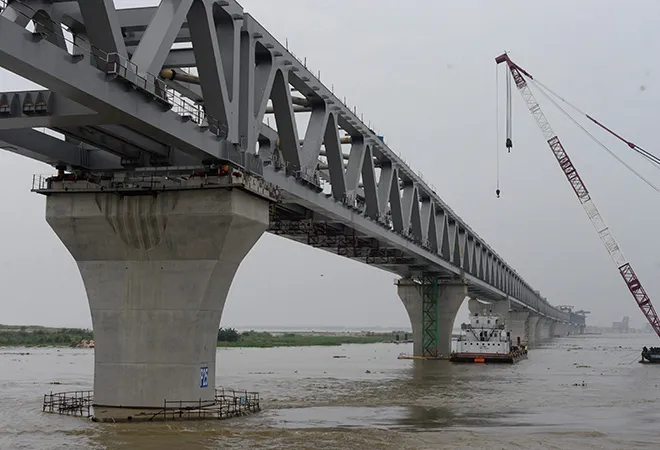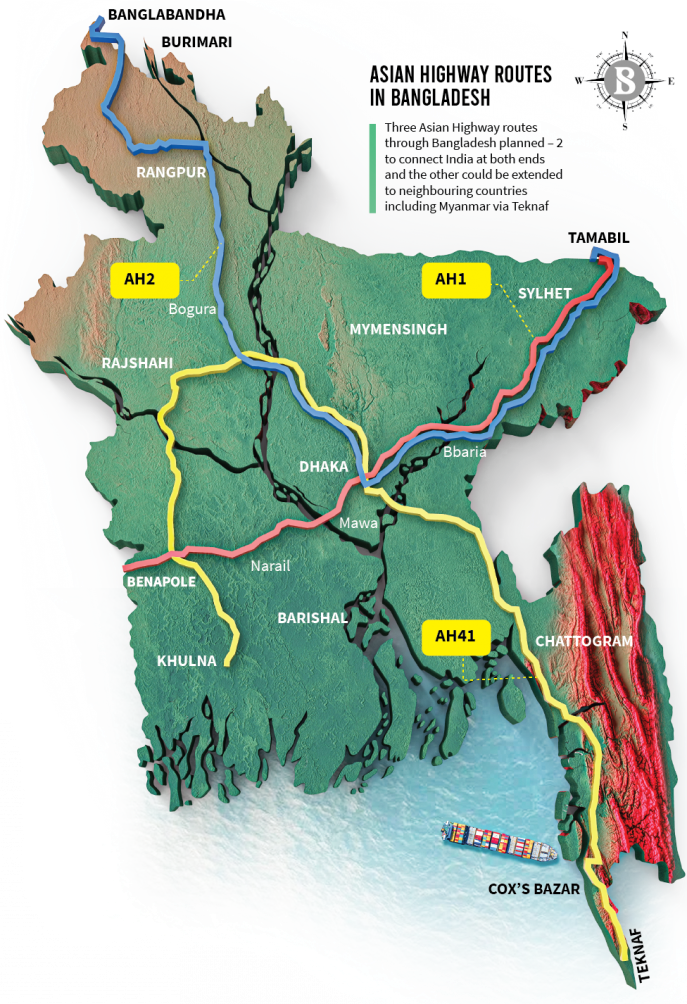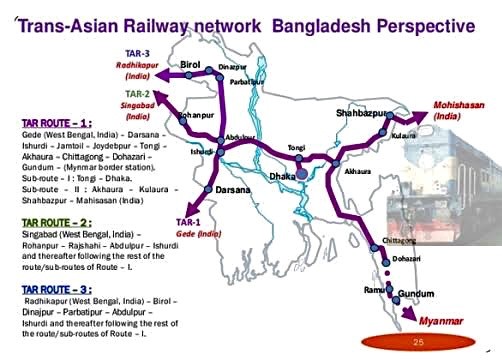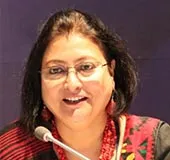
Ushering in a new era of Bangladesh’s connectivity, the Padma Setu (bridge) is being inaugurated on 25 June, by the Prime Minister of Bangladesh Sheikh Hasina. The Padma Multipurpose Bridge Project (PMBP) is a multipurpose rail-road bridge over the Padma River- the downstream part of the Ganges after it enters Bangladesh territory. The main bridge ning 6.15 kilometres is the largest bridge in the country and the second-largest in the Indo-Gangetic Plain. This project is deemed as one of the most innovative yet most challenging developmental projects in the country’s history. In today’s day and age when competing connectivity strategies and investments throng the markets of South Asia, this ‘dream project’ has been funded entirely by the Government of Bangladesh. It is, therefore, important to analyse how it benefits Bangladesh; whether it strengthens the country’s ties with its neighbourhood, and in doing so, does it have the potential to help the incumbent Sheikh Hasina-led Awami League government win the upcoming 2023 elections.
Linking the nation and the region
During the monsoon season, it is often very difficult to cross the turbulent Padma and the ferry ghats face a perpetual problem of congestion. Resolving this challenge and promoting intra-country connectivity is the PMBP, designed to bridge the Mawa and the Janjira banks of the Padma, thereby, linking the southwestern districts of Bangladesh like Faridpur, Jessore, Kushtia, Bhola, and Barishal with those in the northern and eastern parts of the country. This is geared to ensuring smoother movements of goods, services, and people, thereby, boosting trade and connectivity in the process. As the Bangladesh Ministry of Foreign Affairs puts it, this will result “in collective prosperity, socioeconomic development of Bangladesh as well as enhanced regional connectivity.” Furthermore, the PMBP is a two-level steel truss bridge with a railway track operating at the first level while vehicular traffic operates on the second level. The railway track connects the major cities of Jessore and Dhaka and shall shorten travel time, in comparison to the 8-hour journey via the Bangabandhu Bridge. It is expected to be operational by 2024.
Resolving this challenge and promoting intra-country connectivity is the PMBP, designed to bridge the Mawa and the Janjira banks of the Padma, thereby, linking the southwestern districts of Bangladesh like Faridpur, Jessore, Kushtia, Bhola, and Barishal with those in the northern and eastern parts of the country.
From the regional lens, the railway track also has the potential to boost connectivity between Bangladesh and its neighbourhood, which is a manifestation of the country’s foreign policy priorities. Following the project’s implementation, travel time from Dhaka to Kolkata for instance, shall reduce to three to four hours as per senior Bangladesh railway officials. If further connected with the Akhaura-Agartala rail link which is only 159 km from the Padma Setu, it will also connect Bangladesh with India’s Northeast. Due to the bonhomie between India and Bangladesh, promoting connectivity initiatives has been the natural course of the growing ties. In the past months as well as in recent years, Prime Minister Hasina has often urged India to utilise Bangladesh’s facilities such as the Chittagong Port to improve connectivity in its landlocked Northeast region, especially to provide it with an easier access to the sea.
Through this ‘mega-bridge’ Bangladesh will also be a part of the Asian Highway Network that seeks to link 32 countries via roadways to Europe. In the country, work is under progress on three routes-Asian Highway 1 (AH1), Asian Highway 2 (AH2) and Asian Highway 41 (AH41). The bridge forms an essential part of AH1. Further, the Padma bridge’s rail route shall also add to the Trans-Asian Rail Route, which seeks to connect Bangladesh with South Asian and Southeast Asian countries like India, Pakistan, Myanmar, and China through rail connectivity. The new route shall go on to serve as a fourth route, in addition to three existing routes in the country. Through this labyrinth of networks, the Padma Setu has the potential to lend vibrancy to the Mongla and Payra ports which in turn will add value to Bangladesh’s commerce by attracting the trade from India, Nepal, and Bhutan.
 Source: The Business Standard
Source: The Business Standard
 Source: Daily Bangladesh
Source: Daily Bangladesh
Besides facilitating intra-country as well as regional connectivity, the Padma Setu has another value. It is a testament to Bangladesh’s growing capacity and self-reliance by which it has managed to turn an adverse situation into one that salutes its resolve.
The bridge of pride
Henry Kissinger, the renowned American diplomat, had once referred to Bangladesh as a “basket case”. Indeed, the country seemed to be on the brink of realising this stereotype when the World Bank, the Asian Development Banka, the Japan International Cooperation Agency and the Inter-American Development Bank refused to further finance the construction of the bridge owing to alleged “corruption.” Faced with a national challenge, the Bangladeshi government resorted to self-financing the bridge’s construction, proving that it was capable of being self-sufficient and “shrugging off the begging mentality”. Accordingly, it decided to fund the bridge at a cost of US$ 3.6 billion. The country’s citizens also donated 5 takas (4.2 INR) and 10 takas (8.4 INR) each to an improvised bridge fund.
Faced with a national challenge, the Bangladeshi government resorted to self-financing the bridge’s construction, proving that it was capable of being self-sufficient and “shrugging off the begging mentality”
Keeping it a solitary initiative, Bangladesh also refrained from using any foreign funding in the construction of the bridge. It has made it clear that the bridge is not a part of the Chinese Belt and Road Initiative (BRI) and has not been financed by it despite Chinese interests to fund the Padma rail link back in 2018. Indeed, Bangladesh is the second-largest recipient of Chinese funds in South Asia, after Pakistan and many developmental projects such as the Dasherkandi Sewage Treatment Plant and the Dhaka bypass have been financed by it. Off late, however, Bangladesh has displayed prudence in its engagements with China to avoid getting mired in Chinese debts like Sri Lanka. It thus dropped the plan to develop the Sonadia port with Chinese investments. The Padma bridge is a more recent example. Therefore, not only has Bangladesh managed to keep the Padma Setu free from the strings which often come attached with foreign aid, but it has also managed to flip the narrative of being called a “basket case,” by not only transforming its own connectivity but also advancing that of the region. It is, therefore, a major leveraging point for PM Sheikh Hasina as she faces the upcoming elections.
High stakes, high rewards
The Padma bridge’s construction carries immense political stake for the Sheikh Hasina government. Had its construction failed to commence before the upcoming 2023 elections, it would have come off as an empty promise in the Awami League’s election manifesto, thereby, hurting the party’s probable chances for a fourth consecutive win. Delays due to the long gestation period of the PMBP and the lack of transparency in its procurement process are already issues that are likely to be pointed out by the Opposition during its electoral campaigns at the upcoming parliamentary polls. It is also important that the remaining work on the Padma Bridge is completed as scheduled. The Bangladesh government’s website devoted to the PMBP indicates that a little less than 5 percent of work remains on the main bridge.
Delays due to the long gestation period of the PMBP and the lack of transparency in its procurement process are already issues that are likely to be pointed out by the Opposition during its electoral campaigns at the upcoming parliamentary polls.
Having been constructed with the country’s own resources, the government-funded project faced strong opposition within its structure. However, its successful implementation has gone on to add to Bangladesh’s growing economic success. Indeed, the World Bank experts have claimed that Bangladesh had a strong economic recovery—with estimated poverty in the region declining to 11.9 percent in FY 2020-21, as against 12.5 percent in FY 2019-20. Further, the country’s gross national per capita income rose from US$ 2,326 in FY 2019-20 to US$ 2,591 in FY 2020-21. Such data depicts Bangladesh as an economic success story, which in turn, strengthens Sheikh Hasina’s chances of securing her fifth tenure as Prime Minister.
Touted as one of the fastest-growing by the International Monetary Fund, Bangladesh’s economic growth even during the COVID-19 crisis showcased its good resilience. Added to this, its ability to transform the PMBP from vivid imagination to sheer reality on its own steam, fosters the belief amongst Bangladesh’s populace as well the regional countries, that Bangladesh carries the capacity to implement large projects. The PMBP, thus, fulfils three purposes: It enhances domestic and regional connectivity; provides big gains to the Awami League at the 2023 general election; most importantly presents before the world a changing image of Bangladesh.
The views expressed above belong to the author(s). ORF research and analyses now available on Telegram! Click here to access our curated content — blogs, longforms and interviews.






 PREV
PREV




